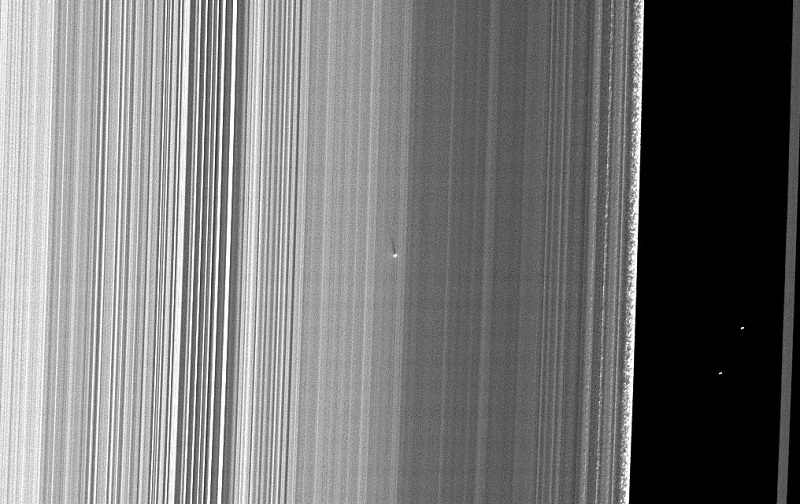NASA dixit:
“July 26, 2009. The Cassini spacecraft captured this image of a small object in the outer portion of Saturn’s B ring casting a shadow on the rings as Saturn approaches its August 2009 equinox. This new moonlet, situated about 300 miles (480 kilometers), inward from the outer edge of the B ring, was found by detection of its shadow which stretches 25 miles, or 41 kilometers, across the rings. The shadow length implies the moonlet is protruding about 660 feet, or 200 meters, above the ring plane. If the moonlet is orbiting in the same plane as the ring material surrounding it, which is likely, it must be about 1,300 feet, or 400 meters, across.
This object is not attended by a propeller feature, unlike the band of moonlets discovered in Saturn’s A ring earlier by Cassini. The A ring moonlets, which have not been directly imaged, were found because of the propeller-like narrow gaps on either side of them that they create as they orbit within the rings. The lack of a propeller feature surrounding the new moonlet is likely because the B ring is dense, and the ring material in a dense ring would be expected to fill in any gaps around the moonlet more quickly than in a less dense region like the mid-A ring. Also, it may simply be harder in the first place for a moonlet to create propeller-like gaps in a dense ring.
This image and others like it are only possible around the time of Saturn’s equinox which occurs every half-Saturn-year (equivalent to about 15 Earth years). The illumination geometry that accompanies equinox lowers the sun’s angle to the ring plane and causes out-of-plane structures to cast long shadows across the rings. This view looks toward the sunlit side of the rings from about 42 degrees below the ring plane. Background stars are visible on the right of the image. They appear elongated by the camera’s exposure time.
The image was taken in visible light with the Cassini spacecraft narrow-angle camera. The view was obtained at a distance of approximately 296,000 kilometers (184,000 miles) from Saturn and at a Sun-Saturn-spacecraft, or phase, angle of 120 degrees. Image scale is 1 kilometer (4,680 feet) per pixel.”
“After almost 20 years in space, NASA’s Cassini spacecraft begins the final chapter of its remarkable story of exploration: its Grand Finale. Between April and September 2017, Cassini will undertake a daring set of orbits that is, in many ways, like a whole new mission. Following a final close flyby of Saturn’s moon Titan, Cassini will leap over the planet’s icy rings and begin a series of 22 weekly dives between the planet and the rings.
No other mission has ever explored this unique region. What we learn from these final orbits will help to improve our understanding of how giant planets – and planetary systems everywhere – form and evolve.
On the final orbit, Cassini will plunge into Saturn’s atmosphere, sending back new and unique science to the very end. After losing contact with Earth, the spacecraft will burn up like a meteor, becoming part of the planet itself.
Cassini’s Grand Finale is about so much more than the spacecraft’s final dive into Saturn. That dramatic event is the capstone of six months of daring exploration and scientific discovery. And those six months are the thrilling final chapter in a historic 20-year journey.”
Image credit: NASA













 Subscribe to our RSS feed
Subscribe to our RSS feed












There are no comments.
Add A Comment